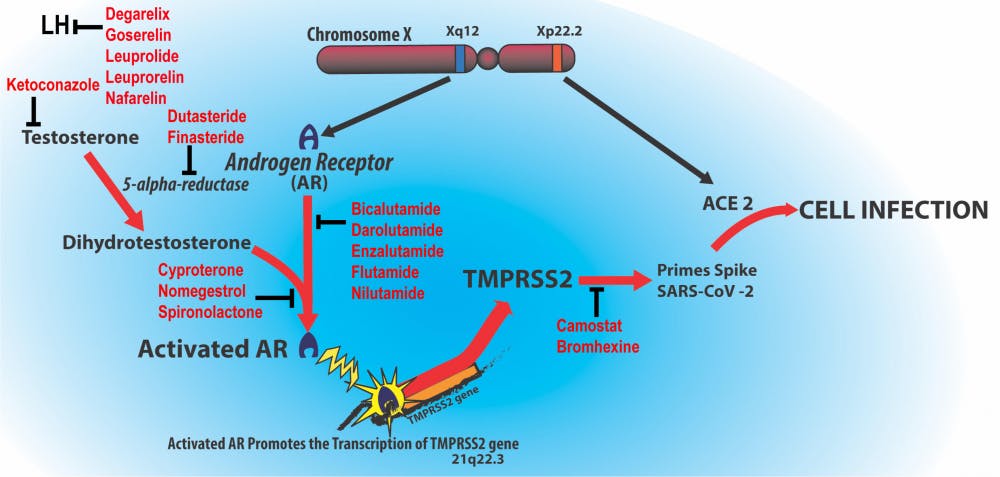In an ongoing, international effort co-led by University Assistant Professor of Dermatology Carlos Wambier, researchers are looking into the potential relationship between androgen, a class of male sex hormones that include testosterone, and infection from COVID-19. They hope to understand at-risk populations and to develop a therapy that could potentially decrease the severity and mortality rate of the virus.
The researchers from the United States, Spain, Italy, India and Brazil have proposed a link between the level of androgens in the body and the severity of the disease. Increased expression of androgen receptors, molecules in the cell that bind androgen to induce a response, is associated with androgenetic alopecia, colloquially referred to as pattern hair loss. “The same androgen receptor might be a gateway to severe COVID-19,” Wambier wrote in an email to The Herald.
The link between COVID-19 and androgen is like a three-legged stool, said Andy Goren, president and chief medical officer at Applied Biology Inc. and co-investigator of the study. The first leg involves an enzyme — a molecular complex that assists with cellular reactions— known as TMPRSS2. To enter human cells, the virus requires this enzyme, which cuts its surface “spike” proteins. The researchers’ hypothesis pointed out that TMPRSS2 is produced in the body when androgen binds to its receptor. “In humans, the only thing that promotes (the gene that codes for this enzyme), as far as we know, is an androgen receptor element. This means that only androgens really are able to promote the expression of this gene,” Goren said.
The second leg of the stool is the ACE2 receptor, a molecule on a host cell’s surface that the virus binds to in order to enter the cell. Former studies “demonstrate that increased androgen levels increase the ACE2 expression,” Goren added.
The third leg involves pulmonary secretions, substances in the lungs that provide protection from viruses and bacteria. They are also inversely related to androgen levels, so larger quantities of androgen result in fewer pulmonary secretions and consequently less defense against the virus, he said.
Due to these three contributors to the virus’s infectivity, the researchers hypothesized that the severity of the virus is androgen-mediated. This connection may explain some trends seen within the population. For example, women generally have lower rates of androgen and have been observed to have less severe cases of COVID-19 and lower rates of mortality than men, Goren said. There have also been limited cases worldwide in children who have not yet reached puberty and would be expected to have lower levels of androgen hormones.
Results from another recently-submitted study conducted by these researchers seem to support their original theory on the link between androgen and COVID-19. In the study on 141 COVID-19 inpatients with severe symptoms, the researchers found that 58 percent of females had androgenetic alopecia, hair loss generally associated with increased levels of androgen. “This is at least five times higher than the general female population of the same age,” Wambier wrote. But for males, the ratio of hair loss in COVID-19 patients compared to that of the general population was 77 to 60 percent — a comparatively smaller difference, Wambier added.
As they move forward, the researchers hope to test their theory and collect more experimental data. “Our idea is to go to the healthcare system, identify (COVID-19) patients who have already been on anti-androgens, like Finasteride for hair loss, and look at the rate of hospitalization of this group compared to an aged matched control” group not taking these medications, Goren said.
The researchers also hope to begin testing treatment in the form of anti-androgens, though Goren recognizes the need to be cautious since their effects on COVID-19 patients are not well-known.
The plan is to use milder medications with fewer side effects as a possible preventative treatment for COVID-19. “Females could use a medication called spironolactone, which inhibits the androgen receptor. Males could use finasteride or dutasteride, which … blocks the production of DHT, a very powerful androgen,” Wambier wrote. In the therapy of severely ill patients, stronger anti-androgens with more side effects would be needed to have a useful effect. Such trials would be closely monitored in a hospital, Wambier added.
“In theory, those (anti-androgens) would be able to be used in a short-term manner if someone (were) infected with (COVID-19),” said Michael Glodé, professor emeritus of medicine at University of Colorado Health Sciences Center, who is not involved in the ongoing research. The medications “could create an advantage for stopping viral replication and viral spread” in COVID-19 patients, he added.

Jared is a Senior Staff Writer for Science and Research. He is a senior from Albuquerque, New Mexico studying physiology and biotechnology. Outside of The Herald he likes to fish, ride bikes and research the role of metals in human health and disease.





